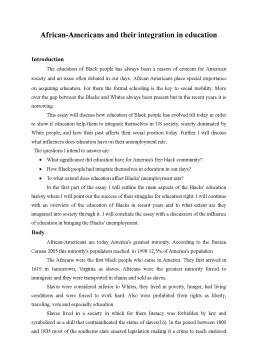Extras din referat
Introduction
The education of Black people has always been a reason of concern for American society and an issue often debated in our days. African Americans place special importance on acquiring education. For them the formal schooling is the key to social mobility. More over the gap between the Blacks and Whites always been present but in the recent years it is norrowing.
This essay will discuss how education of Black people has evolved till today in order to show if education help them to integrate themselves in US society, society dominated by White people, and how their past affects their social position today. Further I will discuss what influences does education have on their unemployment rate.
The questions I intend to answer are:
- What significance did education have for America's free black community?
- How Black people had integrate themselves in education in our days?
- To what extend does education affect Blacks' unemployment rate?
In the first part of the essay I will outline the main aspects of the Blacks' education history where I will point out the success of their struggles for education right. I will continue with an overview of the education of Blacks in recent years and to what extent are they integrated into society through it. I will conclude the essay with a discussion of the influence of education in bringing the Blacks' unemployment.
Body
African-Americans are today America's greatest minority. According to the Bureau Census 2005 this minority's population reached in 1998 12,5% of America's population.
The Africans were the first black people who came in America. They first arrived in 1619 in Jamestown, Virginia as slaves. Africans were the greatest minority forced to immigrate and they were transported in chains and sold as slaves.
Slaves were considered inferior to Whites, they lived in poverty, hunger, bad living conditions and were forced to work hard. Also were prohibited from rights as liberty, traveling, vote and especially education.
Slaves lived in a society in which for them literacy was forbidden by law and symbolized as a skill that contraindicated the status of slaves(16). In the period between 1800 and 1835 most of the southerns state enacted legislation making it a crime to teach enslaved children to write and read (James Anderson, 1988, pp.1). It had an event to take place for Blacks as Civil Rights Act to take advantage and take action for their rights be recognized. First attitude they initiated was Educational Movement (1866).
Seen as a key for a better future for their children, education has become for slaves a goal and a challenge at the same time. Equality aspirations and the stimulating effects of freedom became their main motivation. Black schools were early established and supported largely through the African-Americans' own efforts yet before President Abraham Lincoln issued the Emancipation Proclamation in 1863 and before Congress created the Bureau of Refugees. In 1867 Camdem Blacks, largely through their own individual and collective efforts, established twenty-two schools in which more than four thousand children were instructed. Ex-slaves contributed their money and labor to help make this schools possible, and they organized responsible committees to supervise the schools.(James Anderson, 1988, pp.8).
On 22 March 1864 Banks established a Board of Education to organize and govern the spread of black schools. His effort resulted in 60 schools with eight thousand scholars and more than one hundred teachers. (James Anderson, 1988, pp.12)
The Sabbath schools are the most met schools in southern America. These were established before free and public schools. These church-sponsored schools operated mainly in evenings and an weekends, provided basic literacy instruction. These schools were dominated by Black people and sustained by its' community. In 1869 there were 1,512 Sabbath schools with 6,146 teachers and 107,109 pupils. Sabbath schools continued to grow in the black community long after Reconstruction. (James Anderson, 1988, pp.12-13).
More fundamentally, the ex-slaves struggle for education was an expression of freedom. In 1867 the black Equal Rights Association of Macon, Georgia, resolved: “that a Free school system is a great need of our state, and that we will do all in our power by voice and by vote to secure adoption of a system.” Ex-slaves did much more than establish a tradition of educational self-help that supported most of their schools. They also were the first among native southerners to wage a campaign for universal public education (James Anderson, 1988, pp. 18). By 1865 14 southern states had established 575 schools and these schools were employing 1,171 teachers for the 71.779 Negro and white children in regular attendance. In the entire South in 1870 about one-fourth of the school age ex-slaves attended public schools.(James Anderson, 1988, pp.19)
A first barrier before Blacks were their masters who were not accepting the idea of education for Blacks and decided to take action. Although ex-slaves were able somehow to establish an universal education their owners have become severe with those who tried to implement the system of schools for Blacks. The Compromise of 1877 is a result of presidential elections of 1876. It opposed compulsory school attendance laws and blocked the introduction of a new law which would strengthen the constitutional basis of public education. The planters, with few exceptions, viewed black education as a distinct threat to the racially qualified form of labour exploitation upon which their agrarian order depended. (James Anderson, 1988, pp.23) The planters' heavy use of child labor contributed significantly to their opposition to black education. During good crop years black school terms were so short and irregular that children hardly had time to learn to write and read.
Preview document
Conținut arhivă zip
- African-Americans and Their Integration in Education.doc







